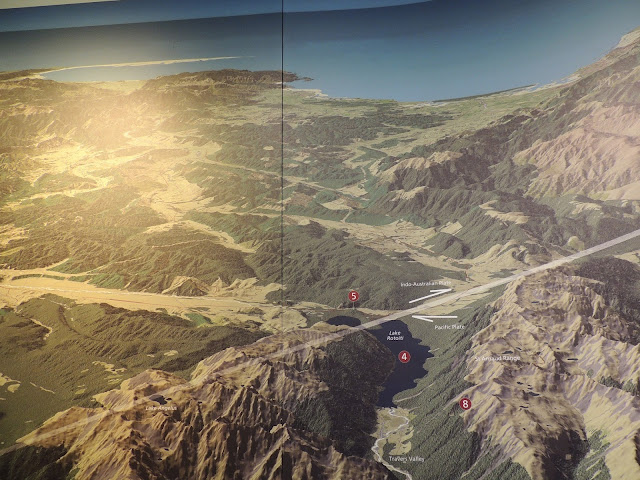Our walk started with the boat drop-off at Tonga Quarry.
This is a famous arch. The captain told us a couple was married inside it.
Much diversity on this hike, and plenty of fern trees.
Walking uphill soon pays off with this view of turquoise, translucent water.
A short walk later we traverse Onetahuti Bay, one of the longest beaches on the Abel Tasman.
Handy trail marker on the beach leads to a boardwalk that takes us up and over Tonga Saddle.
Great river flows and ebbs with the tides.
Onetahuti Bridge and boardwalk opened 17 November 2013 with a dawn blessing by local iwi.
(Ed. note: Iwi are the largest social units in NZ Māori society. The Māori word iwi means "people" or "nation," and is often translated
as "tribe" or a confederation of tribes).
Shaped
to represent a traditional Maori waka (canoe), this bridge over the tidal
Onetahuti stream and boardwalk through the wetlands behind the beach
add a new dimension to the coastal track north of Onetahuti. It is no
longer necessary to wait for low tide to cross the stream.
After a lovely boardwalk trek and an uphill path we reach Awaroa Lodge, closed for the season but fun to explore nonetheless. There are lovely organic food gardens and this outdoor space with a grand fireplace.
We're ready for shade and find a cool nook. It's utterly quiet except for birdsong. If you stay here, you step away from phone and internet.
Lunch is the heavily favored Whitestone Probiotic Camembert, fruit, veggies and crackers. I always have a Penguin Little Black Classic in my pack to offset my fear of being stranded somewhere with nothing to read.
From the lodge it's a short walk to Awaroa Bay, another glorious beach and one we posted a video of not long ago.
The tide's out, but I can hear it returning.
The handsome variable oystercatcher makes quick work of lunch.
Beach architecture.
Art glued the sheep's horn we found on a trail onto his walking stick. He's always getting compliments on it and always responds: trail-made.
Soon we're picked up and speeding back down the coast, stopping three times to retrieve walkers from other points along the trail.
It's our private ride for the first leg, but will be near capacity by the time we arrive back in Kaiteriteri.
We picked up a small group of volunteers from the Abel Tasman Birdsong Trust, out trapping stoats and possums who kill birds and eat their eggs. Bless their hearts.
The tui is their proud symbol.























































